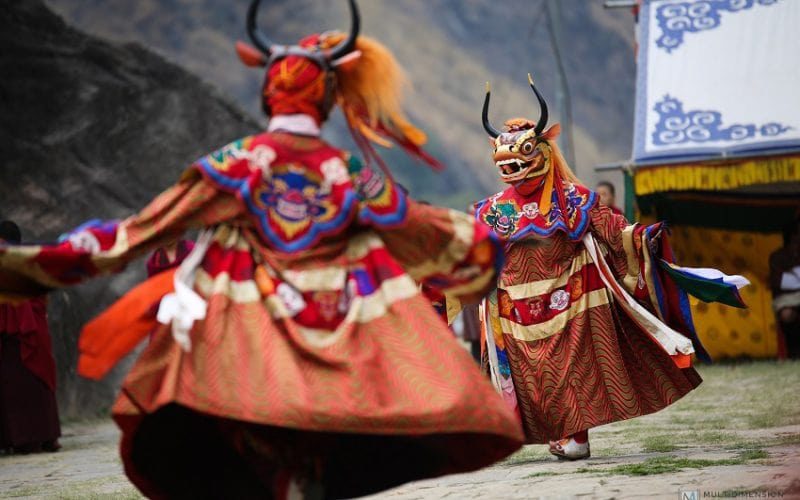Written by : Dr. Anup Shekhar Chakraborty
Photo : shutterstock.com
Winds of Change: Old Friendship Questioned?
What has kept India-Bhutan bromance kindling is Bhutan’s deep social imaginaries of gyagar (holy-land India) linked to the wisdom of the 8th-century Indian Buddhist monk Guru Padmasambhava. Bhutan and its people have diligently stayed true to their religio-cultural links with India- their gyagar neighbour. Over the years, India took its smaller neighbours for granted creating trust deficit among its neighbours and compelled them to wayfind newer friends – Bhutan has mostly been an exception to that trend. India Bhutan camaraderie commemorated 50 years of diplomatic ties.
The Himalayan Kingdom transition from Monarchy to Democracy has been marked by an open-door policy and an inclination to open to a larger world. Having revised the Treaty of Perpetual Peace and Friendship of 1949 with India in February 2007, the Indo-Bhutan Friendship Treaty in its new avatar clarifies Bhutan’s status as an independent and sovereign nation. Under the revised norms, Bhutan no longer requires India’s approval over importing arms. India supports Bhutan’s progress towards sovereignty and democracy.
Bhutan’s significance in India’s ‘neighbourhood gaze’ can be construed from the inherited ‘nonnegotiable position’ that the Himalayan Dragon has marked for itself. For instance, Bhutan became the first country to be visited during the first tenure of the Indian Prime Minister in 2014.
India provides a market for three-fourths of Bhutan’s hydropower, besides investments in the Himalayan nation. Bhutan has stood firm by India in all its entanglements in the neighborhood including the territorial skirmishes with China. Bhutan has inclined towards India even in clash of interests between India-Pakistan.
Unlike Nepal, Bhutan has never played the China card. In recent memory, the camaraderie was squandered in 2012 when then Bhutanese Prime Minister Jigme Thinley met Chinese Prime Minister Wen Jiabao after the Rio+20 Summit. India exhibited its discomfort in the new friendship by withdrawing fuel subsidies to Bhutan. However, India’s public exhibition of pain belittled India’s age-old aura ingrained in the social imagery of the gyagar (holy-land India). The people in the Himalayan nation were taken aback by the official reaction of New Delhi. The new democracy began to construe it as attempts of throttle and smother by a big democracy. It signaled the rising trust deficit and the weaving of the reach of the leadership of the Indian National Congress in the neighbourhood. The inherited ambiguity in India’s foreign policy on its neighbourhood countries has strained its relationship with in South Asia. The immediate fallout of which has been visible on the SAARCs paralysis.
The power tilts and inclinations among nations of South Asia, for instance, ‘Nepal being more comfortable and supportive to Pakistan rather than being smothered by India’s hegemony’ and ‘Nepal and Bhutan post tryst with democracy being on the same page on the point that India is a bully in South Asia.’ The expected Indian responses in other smaller nations’ domestic issues in the neighborhood were not perceived as a problem if it benefitted Nepal. For instance, Nepal had expected India to intervene in Bhutan’s cultural Nationalism phase back in the 1990s that resulted in the ousting of the Nepali speaking people (Lhotshampas). Nepal accused India of not intervening in its most favoured neighbour’s domestic policies. Nepal, in recent times, criticized India on several grounds. It alleged that ‘India and the Modi government did not provide much to Nepal in the post-2015 earthquake-rebuilding programmes’. The economic embargo unleashed through the ‘Chakka bandh/ Nakabandhi 2015’ in the India-Nepal border made life difficult for people in Nepal.’ Nepal also accused India of intervening in the making and adopting ‘the new Constitution of Nepal.’ Nepal’s media (print and televised) reported, ‘India was inclined to the Madhesi.’ The media mediated communication wedged public opinion. Simultaneously, a section was taught to believe that ‘India influenced the proposal to make Nepal a secular state,’ another segment felt that India wanted Nepal to be a Hindu nation.
The fear of being smothered by India’s omnipresence remained overwhelming post-2014. The loudness of Modi’s muscular nationalism made the neighbourhood voices inaudible. The ‘loudness of India’ was further amplified by the televised media houses of India. India’s achievements from sports to beauty pageants to the Nobel Prize, the military might, and cartographic realignments of internal/domestic territorial spaces post the undoing of Article 370 of the Indian Constitution, thus begrudged select neighbours and circulated angst, discomfort, resentment, and a calculated reaction to flush down India’s globally recognised centrality in the Asian geopolitics.
The BJP government post-2014 tried to maximize its space in the neighbourhood by catapulting this ‘trust deficit’ and re-wiring the political connections through its ‘Neighbourhood First Policy’ (NFP). However, Modi’s ‘charm offensive’ adversely affected Indo-Nepal relations during Madhesi movement and pushed Nepal’s diplomatic gaze to its northern neighbour-China. The milestones of Modi’s NFP were mirage-like in the sense that whatever was gained in Sri Lanka and Maldives in 2018 were undone by 2020. Likewise, Bhutan had another reason to harbour closeness with China. It watched with alarm that India itself is finding difficult to hold on its own territory and is trying to save honour being in denial mode.
The Right to look for Newer Friends
The change from a Monarchy to democracy has been webbed with the stories of rising inequalities, unemployment, migrations, political consciousness and assertiveness that question the models of development controlled by India’s ‘grants and loans’. Bhutan’s over-reliance on India and the disillusionment in the economic realm has spilt the public opinion in Bhutan. The emergent voices in a newfound democracy have been pressing for recalibrations of the old ties with India, and make new meanings of the geopolitics. Bhutan’s ‘right to look for newer friends’ and take care of its national interest, including diversification of Bhutan’s foreign policy, has taken centre-stage in the political debates and conversations.
The disgruntled Bhutanese opinion has renewed China’s interest in Bhutan. China has skillfully swayed a section in Bhutan by promising a better future and soft power strategy just as it has done in another Himalayan neighbour- Nepal. Friendship in the region is witness to recalibrations and customizations and being made conditional, with or without benefits. The notion of ‘neighbourhood ties’ in South Asia have forever been shape-shifting, and the notions of friendship in the neighbourhood (real and virtual) oscillate from angst to animosity.
The Dance of the Two Dragons
Bhutan (Norbu Dragon/Peaceful dragon) and China (Lung Dragon/ Aggressive dragon) as the two Dragons have little ethnic affiliations. Periodic territorial incursions and cartographic tensions mark the inherited memories of the two dragons. Though the two dragons share standard frontiers, diplomatic ties have been minimal. The only connectivity that China can leverage is the ‘Tibet-Bhutan shared heritages’. Bhutan has a long tradition of cultural and religious conversations and synergy with Tibet.
Post-Doklam, China has been wooing Bhutan to join the BRI to strengthen its footprint in Bhutan. In its desire to dance with the ‘Norbu dragon’, China has strategically opened the land-ports in the Tibetan region such as the Yadong area adjacent to Bhutan. This invite to ‘come and dance’ and engage with the Chinese economy through Tibet will open foreign trade services in Western China- Qinghai and Gansu provinces and the Xinjiang Uyghur Autonomous Region.
This is in strong contrast to the times in the late 1950s when the 14th Dalai Lama arrived in India and unfettered the region’s geopolitics. Tibet uprising made the security of Bhutan’s border with China a constraint for Bhutan. Thousands of Tibetans fled to Bhutan and were granted asylum after which Bhutan subsequently closed its border to China, fearing the arrival of more refugees. Bhutan’s ties with India and China, the two geopolitical, economic and demographic titans are moulded by history and geography.
China’s territorial Over-drive
China’s territorial claims loom large over trans-Himalayas from Ladakh to Uttarakhand, Nepal to Sikkim, from Bhutan to Arunachal Pradesh and Nepal the Tibet Autonomous Region (TAR). Bhutan had evaded China’s expansionist drive through its skilful engagement with India. The Bhutanese Monarchy had favourably inclined towards its southern neighbour for all-purpose, bypassing conversations and economic arrangements with China. But with the winds of change in the land of ‘Norbu Dragon’ and the evolving of new democracies in the region, India’s alignments with the neighbours have recalibrated exceedingly.
China has been keen to recommence and realign the assemblages of the old trade and cultural connectivities through trans-Himalayas. Bhutan-China relations have been far from smooth. In 1988 China’s PLA troops erected roads and forcibly occupied Bhutan’s territory. Like in the case of Tibet, the western powers turned a blind eye to China’s territorial over-drive, while India stood by the ‘Norbu Dragon’.
China’s territorial over-drive and expansionist strategies have been a cause of apprehension from South Asia to the Indo-Pacific region. China’s military intrusion into Doklam (2017) was one such attempt to destabilize and create a trust deficit towards India in the neighbourhood. The Doklam standoff foreshowed Bhutan’s vulnerability vis-à-vis the ‘Lung Dragon’. China is keen to make Bhutan its cat’s claws. The flag-bearers of ‘right to look’ and find newer friends should read with caution the smooth talk of China’s ‘debt diplomacy’ and learn from the experience of Sri Lanka, Pakistan and few African countries. Bhutan should weigh the pragmatism in its ‘bromance’ with its age-old Southern friend before being overzealous of possible ‘dance’ with a new friend.
Related Article : Nepal-India Virtual Neighbourhood ‘Halla Gulla’
(The views expressed in this article are the author’s own and do not necessarily reflect Multidimension’s editorial stance.)
About the author :
Dr. Anup Shekhar Chakraborty
Assistant Professor, Department of Political Science and Political Studies, Netaji Institute for Asian Studies, & member, Mahanirban Calcutta Research Group, Kolkata
Visiting Faculty, Department of South and South East Asian Studies, University of Calcutta.




